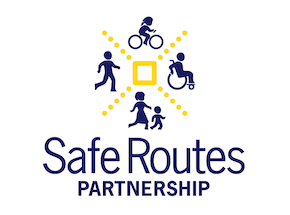Resource Library
 We love it when Safe Routes to School volunteers and champions share what is happening in their community with us!
We love it when Safe Routes to School volunteers and champions share what is happening in their community with us!
The Indiana Safe Routes to School program is alive and well! Having completed six application rounds since its inception in 2006, there are now 114 infrastructure projects and non-infrastructure activities that have been awarded funding in the Hoosier State. For a map of Indiana’s Safe Routes to School awards click here.
All Safe Routes to School programs benefit from evaluation. Thoughtful data collection and analysis helps communities to identify issues, appropriate strategies to address those issues, set goals, and determine results. Data collected can further influence funding by providing a fuller picture of community needs and prospective projects.
In our upcoming September webinar, we will delve into tools to support your funding applications and existing programs. The one-hour session will include an overview of Colorado’s EnviroScreen, an interactive environmental justice mapping and health screening tool developed for the Colorado Department of Public Health and Environment (CDPHE). This dynamic resource enables users to identify areas with current and past environmental inequities, pinpoint areas where disproportionately impacted communities have a greater health burden and/or face more environmental risks and identify geographic areas that meet the definition of disproportionately impacted communities under Colorado law.
Additionally, given the closure of the National Safe Routes to School Data System, we will be discussing new means of recording student travel tallies and parent surveys. This data is a required component for Colorado Safe Routes to School grant applications. All those interested in submitting applications for our upcoming Colorado Safe Routes to grant cycle, join us as we share our suggestions to help you prepare your best submission!
*Note: While this webinar is designed to give an overview of tools available for evaluation within your program, special attention will be given to attendees preparing a Colorado Safe Routes to School FY 25 Application.
 Safe Routes to School is about walking and bicycling to school and in communities. The Safe Routes to School momentum spreads to players at all levels. There are only three communities with designated Safe Routes to School coordinators in the Greater Washington, DC region.
Safe Routes to School is about walking and bicycling to school and in communities. The Safe Routes to School momentum spreads to players at all levels. There are only three communities with designated Safe Routes to School coordinators in the Greater Washington, DC region.
The Safe Routes to Parks is a research-backed intervention to boost rates of physical activity that can have positive health benefits. In a systematic review, the Community Preventive Services Task Force found a significant increase in physical activity related to parks, greenways, and trails when they are paired with at least one other intervention – community engagement, structured programs, public awareness, and/or access enhancements. Safe Routes to Parks is a programmatic way to apply that research to boost physical activity in your community. This factsheet outlines five actions champions can take to get started.
 This week, Congress is voting on a new two-year transportation bill, called MAP-21, that will make significant changes to federal transportation policy that negatively impact bicycling and walking programs. Please see our joint statement with the America Bikes coalition for information on the effec
This week, Congress is voting on a new two-year transportation bill, called MAP-21, that will make significant changes to federal transportation policy that negatively impact bicycling and walking programs. Please see our joint statement with the America Bikes coalition for information on the effec
The Safe Routes Partnership has pulled together resources to help applicants successfully win Safe Streets and Roads for All funding. In 2025, there is $1 billion available for communities through the Safe Streets and Roads for All program to develop plans and implement strategies to improve roadway safety. Applications are as short as two pages, and chances of success are very high. The deadline is June 26, 2025. The Safe Routes Partnership is here to help you win this funding.
Helpful Information
Frequently Asked Questions
More Information about SS4A
Worksheets
Digital versions of the below worksheets are available to copy and reuse for your community via Google. Google will prompt you to make a copy of the worksheet first.
Want to edit it in Word? Click File > Download
SS4A Implementation Grant Worksheet
SS4A Demonstration Worksheet
 Since Congress released their new MAP-21 Transportation Bill two weeks ago, which eliminated dedicated funding for Safe Routes to School and leaves most of the decision making for active transportation up to states and locals, people have been asking me “what’s next?”
Since Congress released their new MAP-21 Transportation Bill two weeks ago, which eliminated dedicated funding for Safe Routes to School and leaves most of the decision making for active transportation up to states and locals, people have been asking me “what’s next?”

 I have written before about how well the state network project is doing. Looking at the first seven months, I am happy to report there has been a real growth spurt as the number of participants increases, as do the contact lists. And the organizers’ skills are getting noticed as are the networks activities. Here are some snapshots:
I have written before about how well the state network project is doing. Looking at the first seven months, I am happy to report there has been a real growth spurt as the number of participants increases, as do the contact lists. And the organizers’ skills are getting noticed as are the networks activities. Here are some snapshots:
Montana Safe Routes to School continues to improve safety and healthy options for children across Montana. In March of 2012, Montana Safe Routes to School announced $928,406 in Safe Routes to School awards for state fiscal year 2013, which began July 1, 2012. Six communities were awarded infrastructure funding for projects ranging from $14,000 for signing and crossing improvements to $114,386 for a pathway in eastern Montana.
 The Safe Routes Partnership's state network project is working to get more Complete Streets policies and improve current ones. As we do this, we learned about several jurisdictions in Florida that have taken their own initiative and are doing just that. We will continue to work hard to make sure this trend continues in our network states!
The Safe Routes Partnership's state network project is working to get more Complete Streets policies and improve current ones. As we do this, we learned about several jurisdictions in Florida that have taken their own initiative and are doing just that. We will continue to work hard to make sure this trend continues in our network states!
In 2012, the MAP-21 transportation legislation made changes to the Federal Safe Routes to School program that added a required state or local match of up to 20 percent of project costs.
 New Jersey’s Zealous Nuts: The 2012 ProWalkProBike: Pro Place conference brought together hundreds of “zealous nuts” who are dedicated to people walking and bicycling more often. Fred Kent, founder of Project for Public Spaces, opened the c
New Jersey’s Zealous Nuts: The 2012 ProWalkProBike: Pro Place conference brought together hundreds of “zealous nuts” who are dedicated to people walking and bicycling more often. Fred Kent, founder of Project for Public Spaces, opened the c
This webinar from December 9, 2014 explores the process used to create Complete Streets in a variety of southern settings.
 There is a scene, from a once famous movie where this guy busts through the door to expel his undying affection for a woman. She completes him, and he wants to make sure she knows it.
There is a scene, from a once famous movie where this guy busts through the door to expel his undying affection for a woman. She completes him, and he wants to make sure she knows it.
I’m no Tom Cruise, but I want you to know: You complete me.
 The Safe Routes to School Mississippi network prides itself on the ability to connect with those organizations within the state that are passionate about ridding the state of the childhood obesity epidemic. We continue our efforts in expanding our parameters to partners that are champions for the cause. While attending a meeting with the Obesity Coalition (formulated by The Partn
The Safe Routes to School Mississippi network prides itself on the ability to connect with those organizations within the state that are passionate about ridding the state of the childhood obesity epidemic. We continue our efforts in expanding our parameters to partners that are champions for the cause. While attending a meeting with the Obesity Coalition (formulated by The Partn




 Our work to expand the region’s Active Transportation program at the Southern California Association of Governments (SCAG) is progressing.
Our work to expand the region’s Active Transportation program at the Southern California Association of Governments (SCAG) is progressing.